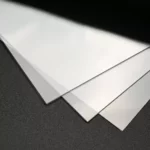
Polyester Hard-coating Film

PET Diffusion Film
Description
Kaixin printing polyester film is a green, environmentally friendly polymer film material with excellent comprehensive properties. It has the characteristics of high mechanical strength, good rigidity, strong toughness, excellent insulation, high gloss, transparent, non-toxic, odorless, wear-resistant, folding-resistant, pinhole puncture-resistant and tear-resistant. The surface has been pre-coated to increase the ink adhesion, making it perfect for UV printing, screen printing and digital printing.
Printing Process
- Printing lamination method. Use offset printing to extract ink, and immediately cover it with matte PET or BOPP film for die-cutting after printing, so there is no problem of ink drying. This type of processing does not have any requirements on the surface properties of the material. PET or BOPP with matte surface can be printed with ribbons. This method is a commonly used method for measurement. However, the cost is high, and large labels are prone to label bending after lamination.
● Printing glazing method. Use UV ink, print online on a rotary label machine, and apply UV varnish. The glazing process can use entire glazing or partial glazing, leaving the printing area reserved. This method is also a method commonly used by customers.
● UV printing method. Printed using UV ink. No laminating or glazing is required, the printing area is reserved.
● Printing and drying method. Special oxidative polymerization quick-drying special ink is used. After printing, it is dried in a hot air drying tunnel and finally rewinded.
● Natural in drying method. This type of label is usually used for manual labeling, so the processing method is to roll printing and then cutting. After printing, the labels should be put on the shelf to dry naturally after cutting. Similarly, the ink used is a special oxidative polymerization quick-drying special ink.
Surface Treatment Methods Of PET Film
Surface treatment methods of PET film are divided into corona and coating:
● Corona treatment. Through high-voltage discharge, the surface energy of the material is increased. There are two methods: pre-processing by the supplier when making the material and online processing on the printing press. The surface tension of the treated film is required to be above 38dyn. It should be noted. No matter how much current is used to corona some PET materials, the surface tension value cannot be increased. Therefore, in fact, not many manufacturers use the corona method for surface treatment. Because the quality is unstable, ribbon printing cannot be performed in the end.
● Surface coating. Pre-coated an ink-friendly coating on the surface of the material, such as corona -free PET film surface treatment agent and PET film surfacetreatment agent, to improve its wetting ability for the ink and increase the firmness of the ink. This treatment method is the most ideal, most common and most stable method for PET materials. This is also the surface treatment method used by Kaixin PET.
Features
- Excellent creep resistance, fatigue resistance and wear resistance
- Cost-effective, easy to process and durable
- Good electrical insulation performance, little affected by temperature
- Non-toxic, weather-resistant, stable against chemicals, and highly hygroscopic
- Good ink adsorption capacity
Applications
- Screen printing on the appearance surface of plastic parts of electronic products. Electronic products, especially digital cameras, MP4s, televisions, computers, etc., have very high requirements for appearance. After the development of plastic screen printing, it brought convenience to the decoration of electronic products.
- Screen printing of plastic signs. In recent years, plastic signs and decorative parts with screen-printed graphics and text after plastic molding have developed rapidly.
- Screen printing of instrument panel.
- Screen printing of colorful polyester signs.
Technical Data Sheet
| Typical physical properties | |||
| Properties | Value | Unit | Test method |
| Physical properties | |||
| proportion | 1.4 | g/cm³ | ASTM D792 |
| Optical properties | |||
| Transmittance | >91 | % | ASTM D1003 |
| Haze | <1.2 | % | ASTM D1003 |
| Mechanical behavior | |||
| Tensile strength (TD) | 200 | Mpa | ASTM D882 |
| (MD) | 170 | Mpa | ASTM D882 |
| Elongation at break (TD) | 120 | % | ASTM D882 |
| (MD) | 170 | % | ASTM D882 |
| Thermal properties | |||
| Molding shrinkage(TD) | 0.1 | % | ASTM D1204 |
| (MD) | 1.1 | % | ASTM D1204 |
| Surface Tension | 46 | mN/m | ASTM D2578 |
| Note: This test is for reference only and is not an absolute application indicator. | |||

